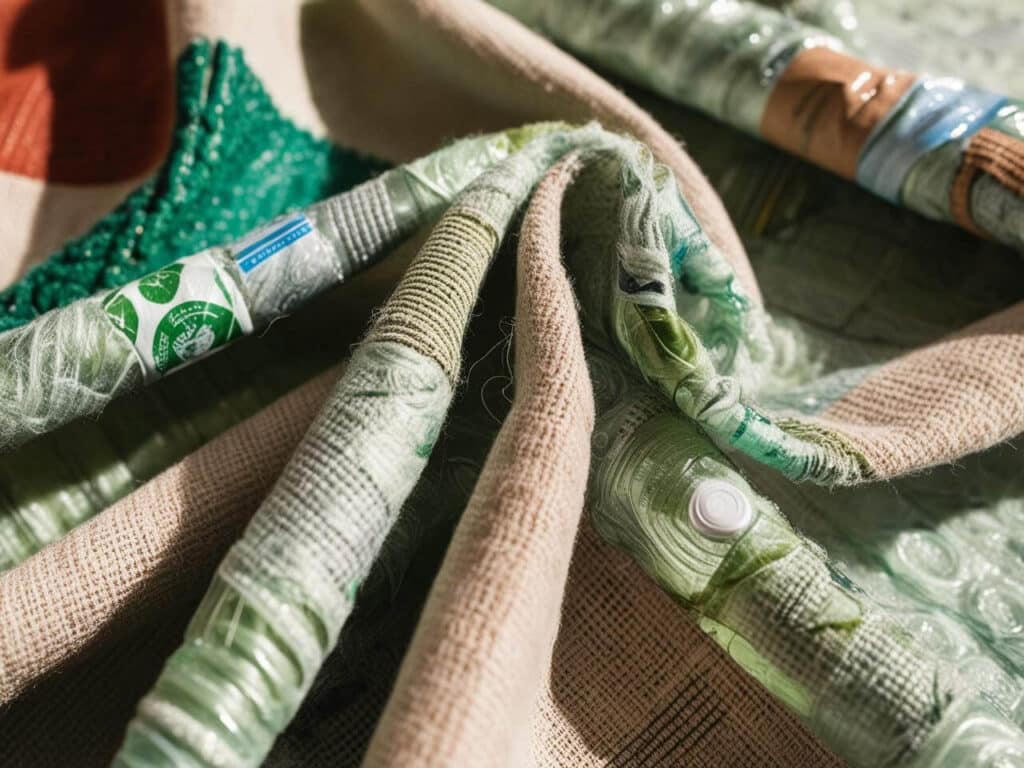Introduction
I’ve always been fascinated by the sustainability movement in fashion, and recycled fabric is at the heart of this transformation. With the rise of eco-friendly clothing and circular fashion, more brands are turning to recycled materials to reduce waste and environmental impact.
But what exactly is recycled fabric, and how does it compare to traditional textiles? In this guide, I’ll break down its benefits, how it’s made, and why it’s shaping the future of fashion and textiles.
What You’ll Learn in This Guide
✔ What recycled fabric is and how it’s made
✔ The key differences between recycled and virgin fabrics
✔ The types of recycled fabrics, including rPET, recycled cotton, and ECONYL®
✔ How recycled fabrics are used in fashion, home textiles, and technical applications
What is Recycled Fabric?
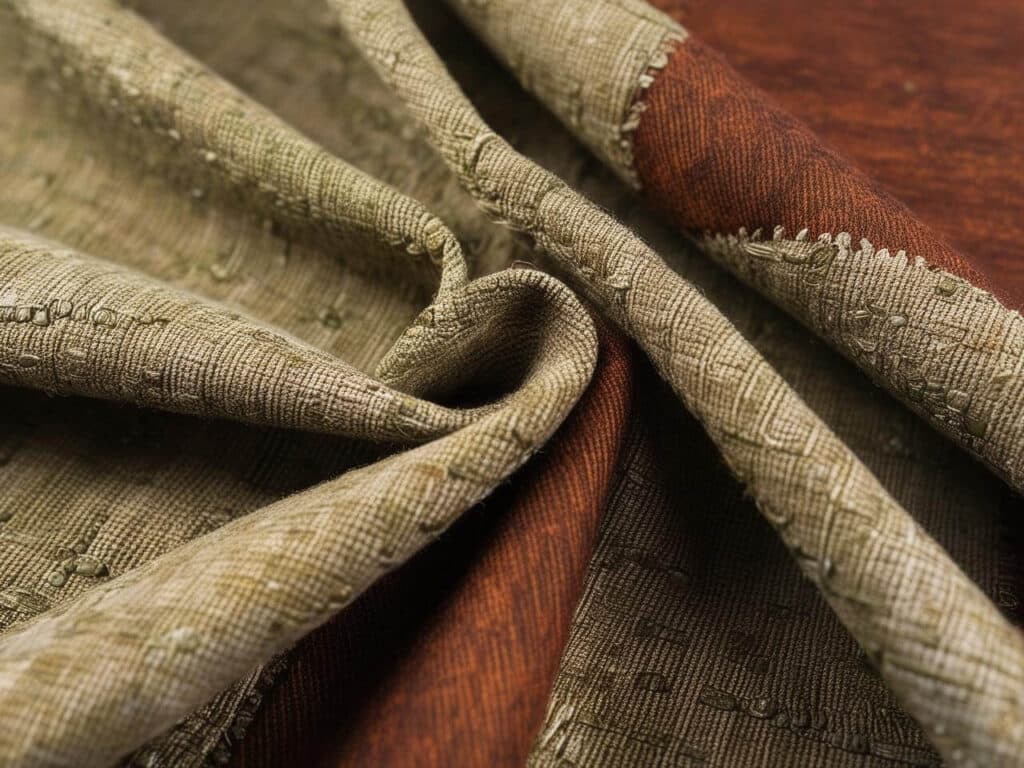
Recycled fabric is a sustainable textile made from repurposed materials such as plastic bottles, discarded clothing, and industrial textile waste. This eco-friendly alternative helps reduce waste, water consumption, and carbon footprint, making it an essential component of sustainable fashion and home textiles.
📌 Key Features of Recycled Fabric
- Made from post-consumer & post-industrial waste – Includes recycled polyester (rPET), nylon, cotton, and wool.
- Eco-friendly production – Uses less water, energy, and chemicals than virgin fabric production.
- Maintains performance & durability – High-quality recycled fabrics like rPET and ECONYL® offer similar strength to virgin materials.
- Versatile applications – Used in fashion, sportswear, upholstery, and industrial textiles.
| Feature | Description |
| Sustainability | Reduces waste and environmental impact |
| Common Sources | Plastic bottles, old textiles, fishing nets |
| Durability | Similar to virgin fabrics (varies by type) |
| Water & Energy Use | Lower than virgin fabric production |
| Best Uses | Fashion, home decor, sportswear, automotive |
✅ Key Advantage: Recycled fabric promotes a circular economy, reducing landfill waste and extending the life of raw materials.
🎥 Recommended YouTube Video
📌 How Recycled Fabric is Changing Fashion
🎬 A documentary-style video explaining the importance of textile recycling and its impact on the fashion industry.
Types of Recycled Fabrics
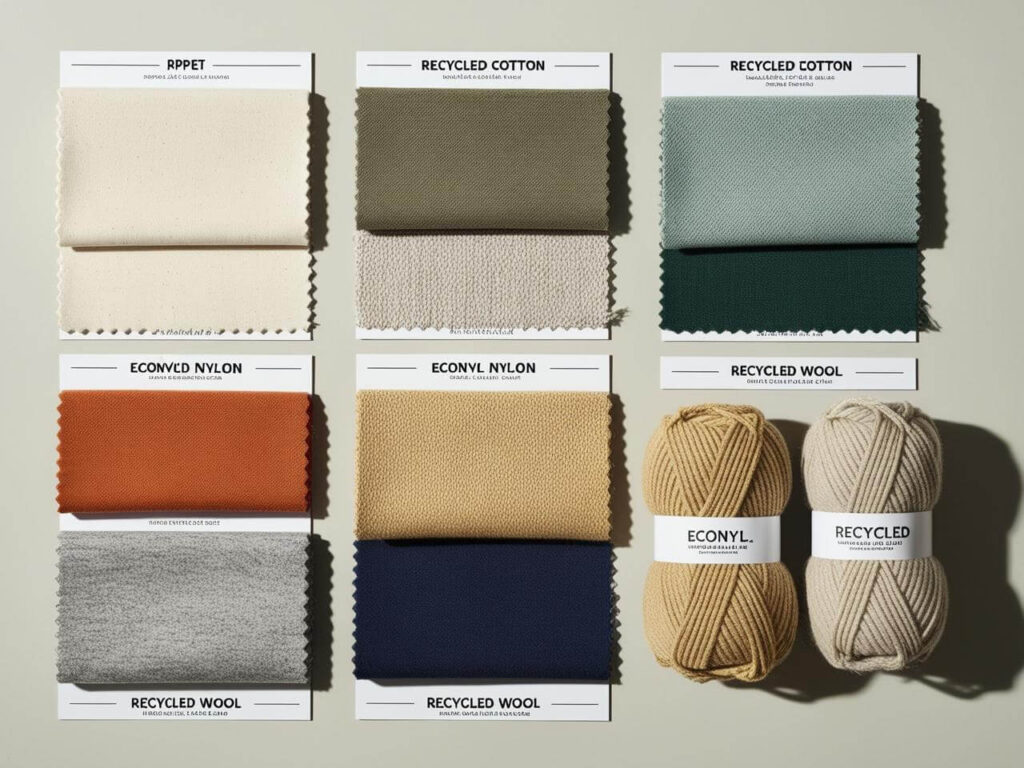
Recycled fabrics come in many forms, each with unique properties and applications. Below are the most common types of recycled fabrics used in fashion, activewear, and home textiles.
📌 1. Recycled Polyester (rPET)
- Made from: Recycled plastic bottles and industrial polyester waste.
- Properties: Lightweight, durable, moisture-wicking, wrinkle-resistant.
- Best Uses: Activewear, jackets, sportswear, backpacks, upholstery.
✅ Sustainability Benefit: Producing rPET uses 59% less energy than virgin polyester and helps divert plastic waste from landfills.
📌 2. Recycled Cotton
- Made from: Discarded cotton textiles, old clothing, and fabric scraps.
- Properties: Soft, breathable, retains some natural elasticity.
- Best Uses: T-shirts, denim, home textiles, eco-friendly casual wear.
✅ Sustainability Benefit: Saves 20,000 liters of water per kilogram compared to growing new cotton.
📌 3. Recycled Nylon (ECONYL®)
- Made from: Abandoned fishing nets, carpet waste, and industrial nylon scrap.
- Properties: Strong, flexible, lightweight, quick-drying.
- Best Uses: Swimwear, leggings, yoga wear, lingerie, high-end fashion.
✅ Sustainability Benefit: Prevents marine pollution by repurposing ocean waste.
📌 4. Recycled Wool & Cashmere
- Made from: Recycled wool garments and textile industry offcuts.
- Properties: Warm, insulating, moisture-wicking, biodegradable.
- Best Uses: Sweaters, scarves, winter coats, blankets, upholstery.
✅ Sustainability Benefit: Extends the life of natural fibers, reducing sheep farming emissions.
📌 5. Recycled Blends
- Combination of: Recycled polyester, cotton, nylon, and spandex for enhanced performance.
- Properties: Combines stretch, breathability, and durability.
- Best Uses: Eco-friendly denim, activewear, and outdoor gear.
✅ Sustainability Benefit: Reduces waste from multiple sources while maintaining high functionality.
🎥 Recommended YouTube Video
📌 5 Types of Recycled Fabrics You Need to Know
🎬 A breakdown of the most popular recycled textiles and their sustainability impact.
How is Recycled Fabric Made?
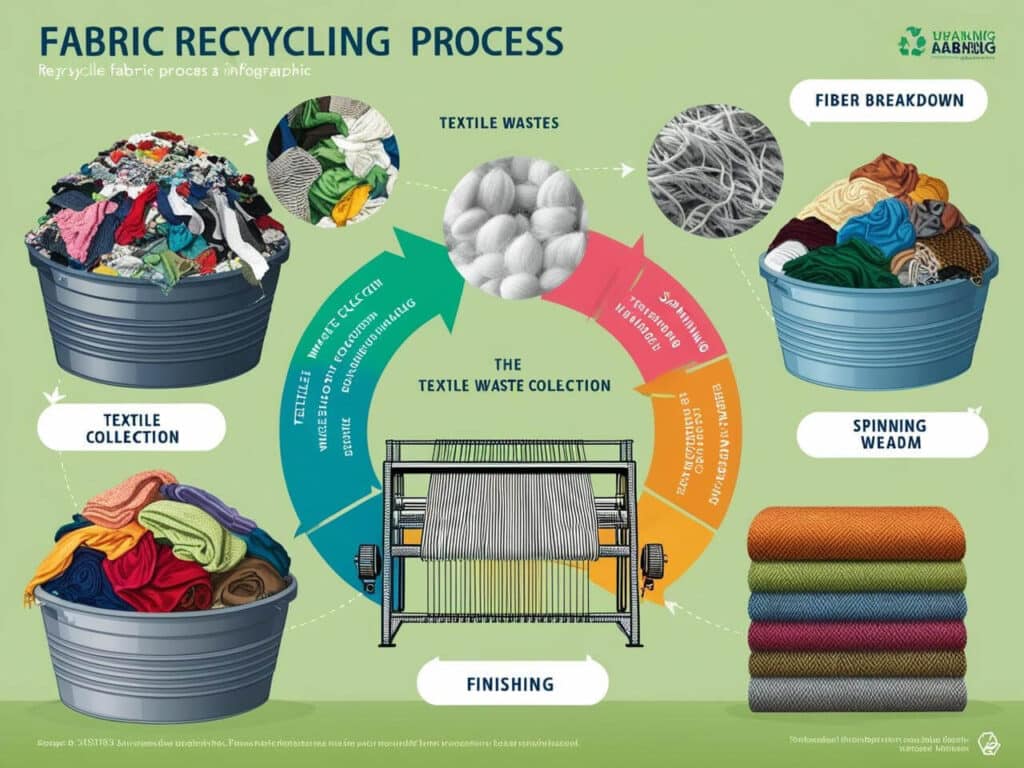
The process of fabric recycling varies depending on the type of material, but the main goal is to convert waste into new, usable fibers while reducing environmental impact.
📌 1. The Textile Recycling Process
1️⃣ Collection & Sorting – Old textiles, plastic bottles, or industrial fabric waste are collected.
2️⃣ Cleaning & Processing – Materials are cleaned to remove dyes, chemicals, or debris.
3️⃣ Mechanical vs. Chemical Recycling:
- Mechanical Recycling – Shreds textiles into fibers and spins them into new yarn (used for cotton and wool).
- Chemical Recycling – Breaks fibers down into raw polymers, which are then re-spun into new fabric (used for polyester and nylon).
4️⃣ Re-Spinning & Weaving – The recycled fibers are processed into yarn and woven or knitted into new fabric.
5️⃣ Finishing & Quality Control – The final fabric undergoes testing for durability, softness, and colorfastness before use.
📌 2. Mechanical vs. Chemical Recycling
| Method | Process | Best For | Pros & Cons |
| Mechanical Recycling | Fibers are shredded and re-spun | Cotton, wool | ♻ Eco-friendly, but fibers may weaken |
| Chemical Recycling | Fibers are broken down at a molecular level and re-polymerized | Polyester, nylon | ♻ Produces high-quality fabric, but requires more energy |
✅ Key Insight: Chemical recycling preserves fiber strength better, but mechanical recycling is a simpler, lower-energy process.
🎥 Recommended YouTube Video
📌 How Recycled Fabrics Are Made – A Behind-the-Scenes Look
🎬 A visual walkthrough of how recycled plastic bottles and fabrics are transformed into new textiles.
Uses & Applications of Recycled Fabric

Recycled fabrics are versatile and widely used across different industries, ranging from fashion and home textiles to automotive and industrial applications.
📌 1. Fashion & Apparel
Sustainable fashion brands are increasingly using recycled materials to create eco-friendly clothing.
| Garment Type | Why Recycled Fabric is Used |
| Activewear & Sportswear | Lightweight, moisture-wicking, and durable (rPET, ECONYL®) |
| T-Shirts & Everyday Wear | Soft, breathable, and eco-friendly (Recycled Cotton) |
| Swimwear & Lingerie | Stretchable, water-resistant, and comfortable (ECONYL®) |
| Denim & Jackets | Strong, sustainable alternative to virgin cotton (Recycled Denim) |
✅ Best for: Eco-conscious consumers looking for sustainable fashion choices.
📌 2. Home Textiles & Upholstery
Beyond clothing, recycled fabric is a popular choice for home and interior applications.
| Application | Why It’s Ideal |
| Bed Sheets & Blankets | Soft, breathable, and environmentally friendly |
| Curtains & Cushion Covers | Durable and stylish, made from recycled blends |
| Upholstery & Furniture Covers | Strong and long-lasting, reducing textile waste |
✅ Key Insight: Recycled polyester and blended fabrics are often used in upholstery and home decor for their durability.
📌 3. Technical & Industrial Uses
Recycled fabric is also found in automotive, construction, and packaging industries.
- Car Seats & Interiors – Many luxury car brands are now using recycled polyester fabrics in vehicle interiors.
- Outdoor Gear & Backpacks – Recycled textiles are used for water-resistant travel gear and camping equipment.
- Eco-Friendly Packaging – Some brands use recycled textile-based packaging instead of plastics.
✅ Sustainability Impact: Recycled fabric helps industries reduce reliance on virgin materials and decrease carbon emissions.
🎥 Recommended YouTube Video
📌 The Best Uses for Recycled Fabrics in Fashion & Interiors
🎬 A video explaining how recycled fabrics are transforming fashion, home textiles, and industrial applications.
Recycled Fabric vs Virgin Fabric
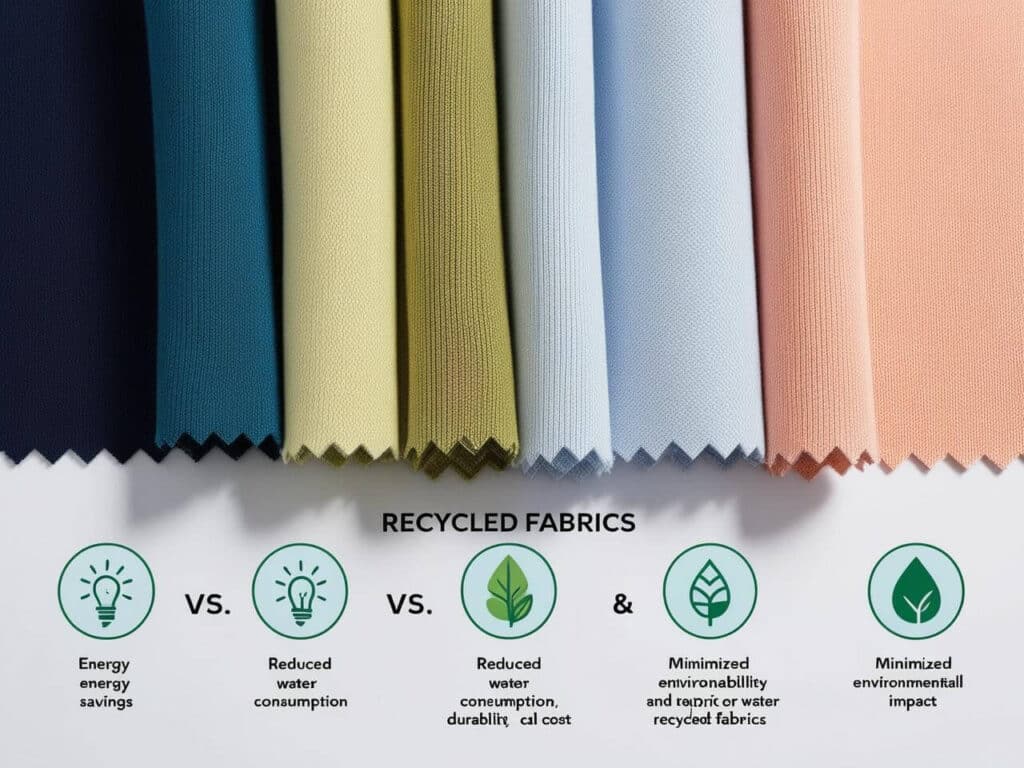
To help consumers and businesses make informed choices, it’s important to compare recycled fabrics with virgin (newly produced) fabrics in terms of sustainability, durability, and cost.
📌 1. Sustainability Comparison
| Factor | Recycled Fabric | Virgin Fabric |
| Environmental Impact | Low – Uses existing materials, reducing waste | High – Requires new resources, contributes to pollution |
| Water & Energy Consumption | Lower – Saves thousands of liters of water per kilogram | Higher – Needs extensive water and energy for production |
| Waste Reduction | Diverts plastic and textile waste from landfills | Creates more waste during production |
✅ Key Takeaway: Recycled fabrics help lower carbon footprint and reduce waste, while virgin fabrics rely heavily on new resource extraction.
📌 2. Durability & Performance
| Factor | Recycled Fabric | Virgin Fabric |
| Strength & Longevity | Similar to virgin polyester & nylon, but recycled cotton may have shorter fibers | Generally stronger and more durable |
| Softness & Comfort | Recycled cotton & wool retain softness, but can be slightly weaker | Natural fibers are soft and long-lasting |
| Stretch & Flexibility | Recycled synthetic fibers (rPET, ECONYL®) perform as well as virgin fibers | Some virgin fabrics (spandex, wool) offer better elasticity |
✅ Key Takeaway: Recycled polyester and nylon maintain similar durability to virgin fabrics, but recycled cotton may be less durable than its virgin counterpart.
📌 3. Cost & Accessibility
| Factor | Recycled Fabric | Virgin Fabric |
| Production Cost | Can be higher due to the recycling process | Often cheaper due to mass production |
| Market Availability | Growing, but still limited compared to virgin fabrics | More widely available in all textile markets |
✅ Key Takeaway: While recycled fabric production can be more expensive, growing demand is driving costs down.
🎥 Recommended YouTube Video
📌 Recycled Fabric vs. Virgin Fabric – Which is More Sustainable?
🎬 A comparison of recycled and virgin fabrics, analyzing their impact on sustainability, durability, and cost.
Pros & Cons of Recycled Fabric
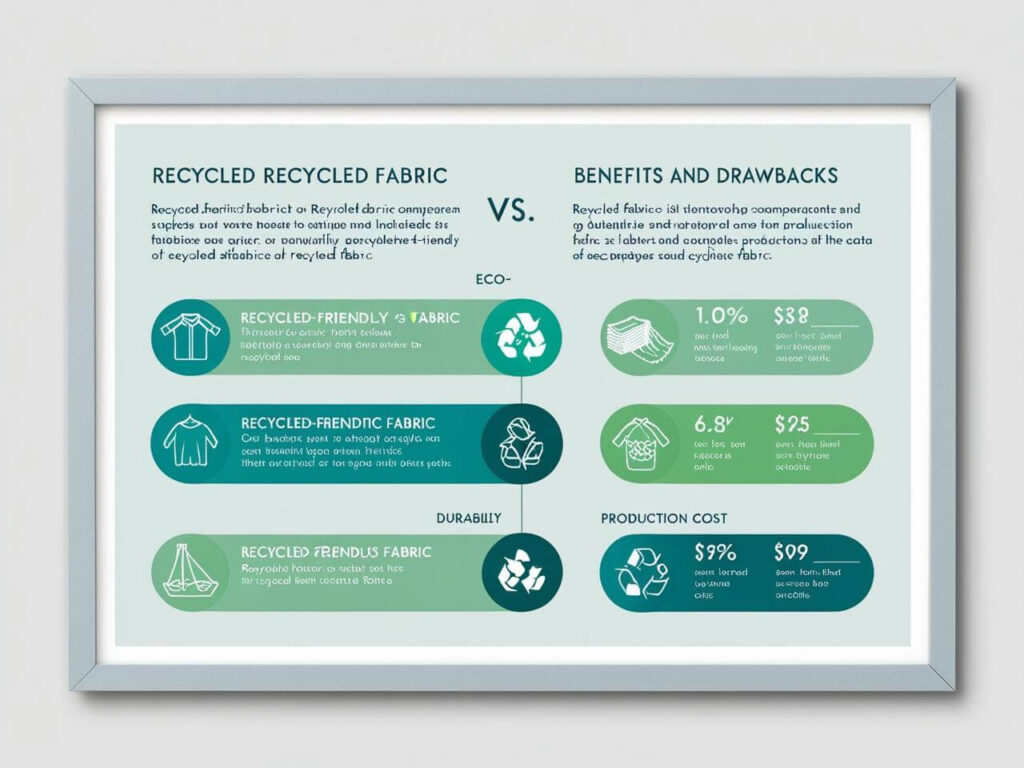
While recycled fabric is a major step toward sustainable fashion and textiles, it comes with both advantages and challenges. Here’s a breakdown:
📌 1. Advantages of Recycled Fabric
✅ Eco-Friendly & Sustainable – Helps reduce textile waste, water consumption, and carbon emissions.
✅ Reduces Plastic & Textile Waste – Keeps discarded plastic bottles, fishing nets, and old garments out of landfills.
✅ Uses Less Water & Energy – Producing recycled polyester requires 59% less energy than virgin polyester.
✅ Maintains Similar Performance to Virgin Fabrics – Recycled polyester and nylon offer the same strength and durability.
✅ Supports Circular Fashion & Ethical Production – Brands using recycled fabrics promote a more sustainable fashion industry.
📌 2. Disadvantages of Recycled Fabric
❌ Higher Production Costs – The recycling process involves sorting, cleaning, and processing, which can increase costs.
❌ Potential Quality Limitations – Some recycled fabrics (like cotton) have shorter fibers, which can reduce durability.
❌ Limited Color & Dyeing Options – Certain recycling methods affect how fabric absorbs dye, limiting color choices.
❌ Not 100% Waste-Free – Some chemical recycling methods still generate emissions, though they are lower than virgin textile production.
🎥 Recommended YouTube Video
📌 The Pros & Cons of Recycled Fabric – Is It Worth It?
🎬 A video explaining the benefits and challenges of using recycled fabrics in fashion and home textiles.
FAQs: Everything You Need to Know About Recycled Fabric
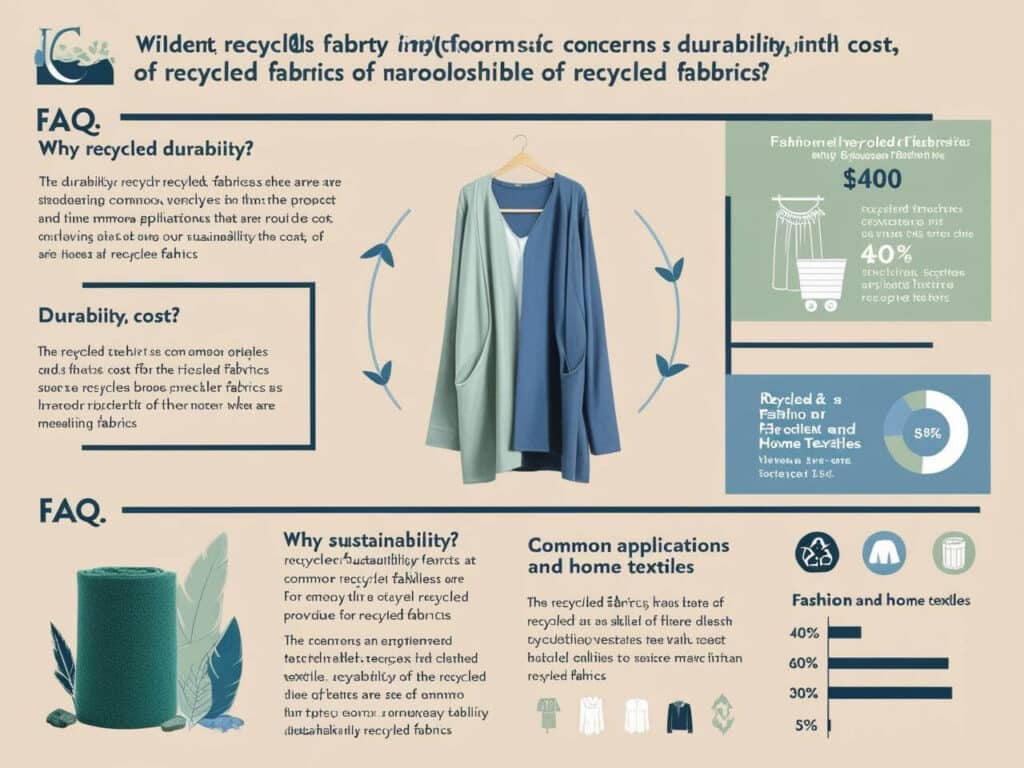
To help clarify common concerns about recycled fabric, here are concise and informative answers to frequently asked questions.
❓ Is recycled fabric as durable as virgin fabric?
✔ Yes, in most cases. Recycled polyester (rPET) and recycled nylon (ECONYL®) perform similarly to their virgin counterparts. However, recycled cotton may be slightly weaker due to shorter fibers.
❓ What are the benefits of recycled fabric?
✔ Sustainability – Reduces waste, water use, and carbon emissions.
✔ Energy Savings – Producing recycled polyester uses 59% less energy than virgin polyester.
✔ Supports Circular Fashion – Encourages textile reuse and waste reduction.
❓ Is recycled fabric expensive?
✔ It depends. Recycled fabrics can be more expensive due to the sorting and processing costs, but as demand grows, prices are becoming more competitive.
❓ Can recycled fabric be recycled again?
✔ Yes, but with limitations. Some recycled fabrics (like polyester) can be reprocessed multiple times, while others (like cotton) may degrade in quality after recycling.
❓ What is recycled fabric best used for?
✔ Most commonly used for:
- Sustainable fashion & sportswear
- Swimwear & outdoor gear
- Eco-friendly home textiles
- Car interiors & industrial textiles
🎥 Recommended YouTube Video
📌 Recycled Fabric Explained – Common FAQs
🎬 A video addressing common questions and misconceptions about recycled fabric.
Final Thoughts: Why Recycled Fabric is the Future of Sustainable Textiles
Recycled fabric is a game-changer in the textile industry, offering eco-friendly alternatives that help reduce waste, energy consumption, and pollution. Whether it’s recycled polyester, cotton, nylon, or wool, these fabrics contribute to a more sustainable fashion and textile ecosystem.
✔ Key Takeaways
✅ Reduces waste & environmental impact – Diverts plastic bottles, old clothes, and industrial scraps from landfills.
✅ Uses fewer resources than virgin fabrics – Saves water, energy, and raw materials in production.
✅ Performs similarly to traditional fabrics – Recycled polyester and nylon retain strength and durability.
✅ Widely used in fashion, activewear & home textiles – Found in sustainable apparel, upholstery, and outdoor gear.
✅ A growing market trend – More brands are switching to recycled materials to promote circular fashion.
If you’re considering recycled fabric for your wardrobe or business, it’s an eco-conscious choice that supports a greener, more sustainable future.
